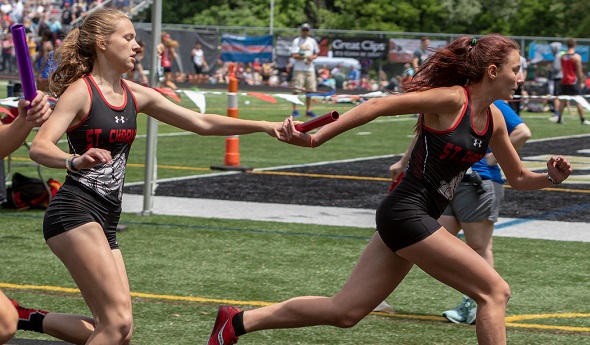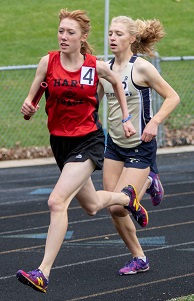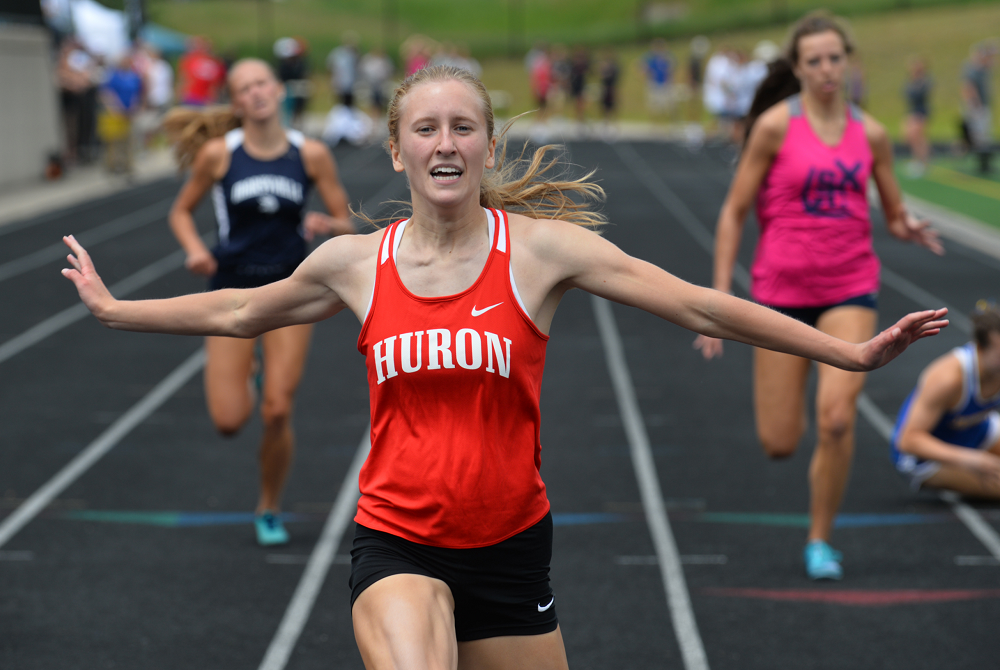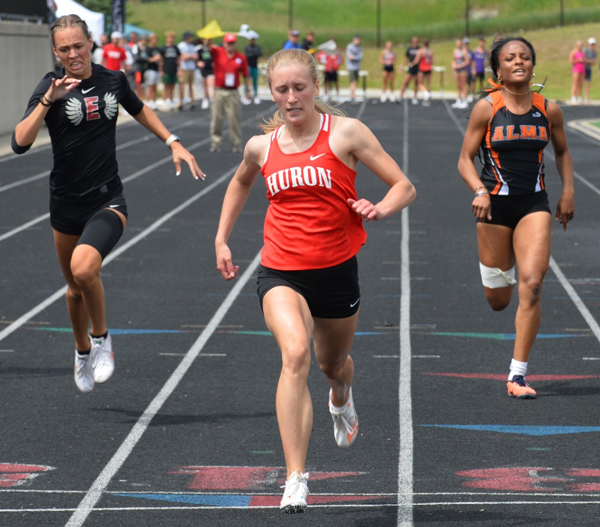
Hart, St. Charles Share Historic Finish
June 2, 2018
By Jeff Bleiler
Special for Second Half
COMSTOCK PARK – Put the Hart and St. Charles teams together, and you’d have had a runaway winner in the Lower Peninsula Division 3 Track & Field Finals on Saturday at Comstock Park.
Hart’s dominance in the distance events and St. Charles’ performances in the sprints would have made it difficult for any other team to challenge for the title.
As it was, each team’s strength countered the other to near perfection as Hart and St. Charles tied for the Division 3 championship with 46 points, earning both their first MHSAA Finals title in this sport.
They finished 10 points ahead of third-place Onsted, which closed the gap by placing fifth in the final event, the 1,600-meter relay. Neither Hart nor St. Charles fielded a team in that event, and Onsted entered it 14 points behind with only 10 available to the winner – so the championship had been decided before that last race even got started.
Both Hart and St. Charles’ coaches were pleased with the shared championship, the first time that’s happened in Division 3 since Laingsburg and Monroe St. Mary Catholic Central split the crown in 2003.
“We had an idea we’d have a chance if we used (junior) Adelyn (Ackley) in three events but didn’t know where she’d end up,” said Hart coach Mindy Whitney, who actually inserted Ackley into a fourth event, which proved critical.
Ackley – who led the cross country team to the LPD3 title in the fall as well – won the 3,200 in 10 minutes, 45.54 seconds; finished runner-up in the 1,600 to Hanover-Horton’s Judy Rector; and placed sixth in the 800, all that after anchoring the winning 3,200 relay in the day’s first event. Alayna Ackley, her older sister, led off and sophomore Brenna Aerts and freshman MacKenzie Stitt filled the second and third slots, respectively, as the relay finished in 9:32.67.
Alayna Ackley also provided valuable points by placing third in the 3,200 despite coming back from a stress fracture injury just last month. The 3,200 was a boon of points for Hart, which picked up 20 in that event alone as the third Ackley sister, freshman Savannah, was fifth.
Whitney said her brother was keeping tabs on the team scoring but after the completion of the 3,200, she thought they came up a point short.
“I was very happy; it was a good day,” she said.
The same could be said for St. Charles, which did its damage in the sprints. Najiyah Holden did the most by winning the 200 in 25.61 seconds, finishing third in the 100 in 12.73 seconds and running the first leg of the winning 400 and 800 relays. The other members of the relays were freshman Hope Kushion and sophomores Erica Garcia and Celine Whiren.
Coach Andre Williams was especially pleased with the 800 relay team’s time of 1:44.97, which broke by three seconds the school record.
“I’m satisfied with (sharing the title),” he said. “After the 400 relay, I knew we had a shot. I told Najiyah she had a shot at winning the 200, and she did. We just don’t have any distance runners.”
 Sprinter Jenna Odykirk of Farwell put to rest previous struggles at the Finals by winning the 100, edging reigning champion Shiyon Taylor of Parchment by two hundredths of a second, and finishing runner-up in the 200.
Sprinter Jenna Odykirk of Farwell put to rest previous struggles at the Finals by winning the 100, edging reigning champion Shiyon Taylor of Parchment by two hundredths of a second, and finishing runner-up in the 200.
Odykirk, who finished a disappointing 16th in the long jump, took solace with her finishes in the sprints after she missed the finals in 2017 in the 200 by one spot and was a distant 16th in the 100.
“I didn’t do too well in the long jump, but I had decent times in everything else,” said Odykirk, whose time of 12.63 seconds in the 100 was a personal best.
Odykirk, a junior, credited the improvement to off season indoor work at Saginaw Valley State University with coach Kyle Payne and outdoor work with Farwell coach Matt Horodyski.
“Next year, my goal is to be state champ in the 200 and the 100, do better in the long jump and run in the 400,” said Odykirk, who qualified this year for the 400 after finishing sixth in the event at last year’s Finals. She opted not to run it Saturday.
In the field events, the shot put provided some late fireworks as Beaverton senior Alicia Aldrich and Clinton’s Amanda Schaare put on quite a show.
In her final attempt with Aldrich on deck, and with the crowd slow clapping as she readied, Schaare heaved it 43 feet, 9¼ inches to move into first. The crowd gave Aldrich a similar slow clap, and she responded with a launch of 44 feet, 7½ inches to take the championship.
“I was like shaking a lot,” Aldrich said. “It feels really great. I wasn’t expecting that at all. The competition really makes you want to throw it farther. I got nervous when I saw Amanda throw it, but then I heard the atmosphere and it pumped me right up.”
Aldrich, who just started competing in shot put last year, will continue in the sport at SVSU.
The runner-up finish for Schaare was not a disappointment as she already had repeated as the discus champion. Schaare won with a toss of 128 feet, beating Sheridan Dinsmore of Caro by six inches.
“(Repeating) was awesome; I really wanted to do that for myself,” Schaare said. “Words just can’t describe it. It’s a feeling that not everyone gets to experience. I just have the greatest support system.”
Schaare’s runner-up put was a personal record, beating the 41-9 she posted early in the season.
“I didn’t finish first in the shot put, but I’m OK with that because with the discus, that would have been icing on the cake,” said Schaare, who will compete in track for the University of Michigan.
Marlette senior Emily Schaub swept the hurdles, winning the 100 hurdles in 15.01 seconds and taking the 300 in 46.96 seconds. She was third in the 100 hurdles a year ago and did not qualify for the 300 final after placing 15th in her 2017 preliminary.
Jackson Lumen Christi freshman Renae Kutcha won the 800 in 58.75 seconds, and Hanover-Horton’s Rector won the 1,600 in 4:52.59. Kutcha also led off the opening leg of Lumen Christi’s winning 1,600 relay team, joining junior Allison Rand, junior Marilyn Schonhard and senior Audrey Warriner with a finish in 4:01.9.
Boyne City senior Anna Harmeling won the pole vault in 11-6, Millington senior Hannah Hall won the high jump at 5-3 and Onsted senior Harlie Sweet won the long jump with a leap of 17-3½.
VIDEO: Holden On For A Bulldogs Co-Championship
PHOTOS: (Top) A pair of St. Charles runners execute a handoff during a relay Saturday. (Middle) Hart's Adelyn Ackley, left, stays a step ahead during one of her relays. (Photos by Annette Tipton. Click for more from RunMichigan.com.)

Multi-Sprint Champ Racing to Finish Huron Career Ahead of the Rest Again
By
Keith Dunlap
Special for MHSAA.com
May 25, 2023
NEW BOSTON – If there was one thing Elizabeth Anderson took pride in elementary school, it was simply showing that she could outrun everyone in sight.
 In fact, Anderson has an explanation for all the success she had in those playground races.
In fact, Anderson has an explanation for all the success she had in those playground races.
“Dominance when you are in elementary school,” Anderson quipped. “I don’t think I ever had a nickname. I just think everyone knew I was fast.”
Years later, pretty much everyone who follows track & field in the state of Michigan can attest to that.
A senior for New Boston Huron, Anderson has been faster than most other competitors in the state during her three-year high school career (with her freshman season in 2020 canceled due to COVID-19).
Last year, Anderson won titles at the Lower Peninsula Division 2 Finals in the 200-meter (25.07) and 400-meter (56.28) dashes, and was runner-up in the 100-meter dash (12.23).
Often, top sprinters focus on one or two of those three races. But Anderson is certainly a different breed of sprinter because she does all three.
In fact, she holds school records in all three of those events, and if all that weren’t enough, Anderson is a part of all three sprint relay teams.
“It is hard to give her events off,” said New Boston Huron head girls track coach Danielle Lobato.
Despite the different styles the 100, 200 and 400-meter dashes present, Anderson said there usually isn’t much adjusting when she goes from one of those races to another.
 The strategy is simply, “Let’s beat the other girls to the finish line.”
The strategy is simply, “Let’s beat the other girls to the finish line.”
“I don’t really go into each race changing up how I would run,” she said.
While enjoying and succeeding in all three races, Anderson said she actually does have a favorite among them.
“I would say the 400 is probably my favorite,” she said. “Even though it hurts, it’s satisfying to see how much you can get your time down in the 400 compared to any other race.”
Anderson said she started running track in sixth grade, but really got serious about it during the summer after her sophomore season, when she was invited to run for a local club.
Eventually, that led to her competing over the winter in indoor events.
She lived and breathed track so much that last fall, she decided to not run cross country so she could focus on a weightlifting regimen aimed at developing more leg strength.
“Once I started doing summer track, I realized I wanted to be doing this all the time,” she said.
Lobato said oftentimes in practice, Anderson is a de facto coach, given there is no better person she can think of for the younger runners on the team to learn from.
“I can’t always demonstrate these things I’m trying to teach,” she said. “You get to see it in real life (from Anderson), not in a YouTube video.”
After winning the 100, 200 and 400-meter dashes at her Regional meet last week, Anderson has her sights set on achieving the same trifecta of titles at next Saturday’s Finals in Grand Rapids.
Anderson has signed to run track at Michigan State, but has been plenty motivated to keep producing this spring in her final high school season.
“I’m really looking to defend my titles,” she said. “That is what is really motivating me to keep going. I want to keep in shape for the college season. I don’t want to lose any of the progress I have made. Ultimately, I just love running track.”
And since elementary school, Anderson has loved — and succeeded in — outrunning everyone else to the finish line.
“We knew we were getting something special,” Lobato said of when Anderson arrived in high school. “But you never expect this. All that she has accomplished is amazing.”
 Keith Dunlap has served in Detroit-area sports media for more than two decades, including as a sportswriter at the Oakland Press from 2001-16 primarily covering high school sports but also college and professional teams. His bylines also have appeared in USA Today, the Washington Post, the Detroit Free Press, the Houston Chronicle and the Boston Globe. He served as the administrator for the Oakland Activities Association’s website from 2017-2020. Contact him at [email protected] with story ideas for Oakland, Macomb and Wayne counties
Keith Dunlap has served in Detroit-area sports media for more than two decades, including as a sportswriter at the Oakland Press from 2001-16 primarily covering high school sports but also college and professional teams. His bylines also have appeared in USA Today, the Washington Post, the Detroit Free Press, the Houston Chronicle and the Boston Globe. He served as the administrator for the Oakland Activities Association’s website from 2017-2020. Contact him at [email protected] with story ideas for Oakland, Macomb and Wayne counties
PHOTOS (Top) New Boston Huron's Elizabeth Anderson clears the finish line during last season's LPD2 400 race. (Middle) Anderson, middle, outpaces the field to also win the 200. (Click for more from RunMichigan.com.)

